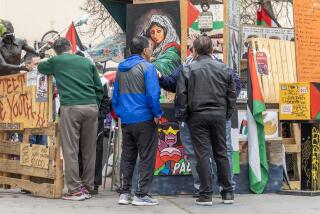College Station Signals Changes in the Air
- Share via
Driving near El Camino College, you may find your radio blasting the “Star Trek” themes, hip-hop music or even the home football games now that the school’s first radio station is on the air.
Students and faculty from the electronics department knitted together about $250 worth of used equipment to create the 15-watt station, which broadcasts at 1620 on the AM dial.
Federal communications law prohibits college radio stations from broadcasting more than a few hundred feet from the school, so don’t expect to hear Radio El Camino throughout the South Bay.
But the station has enough power to be heard on radio headsets and boom boxes across the campus. And students from many departments on campus are getting involved in the programming.
Armando Diaz, 22, takes courses in broadcast journalism. For the radio station, he has developed a sports talk show.
“I’d never seen a (control) board before,” Diaz said. He plans to expand the show to interview athletes on campus and celebrity sports figures as well. He also helps out with the station’s news broadcasts.
Electronics students provide the technical support for the 8 a.m. to 7 p.m. programming. Administrators recruited disc jockeys through flyers and posters, and more than 50 potential radio personalities turned up for the orientation.
As long as their programming doesn’t violate federal laws, students are free to play whatever they want. The disc jockeys air everything from big band jazz to rap, rhythm and blues, and punk, with television themes popping up from time to time. The station also has the capacity to take calls from listeners, but so far, no talk shows are scheduled.
“We’re not looking for any budding Howard Sterns,” said Doug Marston, the electronics instructor who created the station. Marston said he wanted his students to have a chance to get hands-on experience with an AM system, so he kept his eyes open and bought equipment at swap meets and electronics stores.
The system uses electrical lines inside campus buildings as an antenna. The radio signals and electrical current can travel on the same lines because they use different frequencies, Marston said.
Ricardo Lois, 20, is the host of a one-hour show twice a week. His playlist is mainly hip-hop, which he dubs from friends’ tapes or gets from people with garage studios.
“Mostly, I play stuff that doesn’t usually get on the air,” Lois said. His favorite bands include a Tribe Called Quest, Freestyle Fellowship and Ras Kass.
This is Lois’ first time on the air, but he’s not worried it will go to his head.
“This is El Camino--how big can your head get?” Lois said.
More to Read
Sign up for Essential California
The most important California stories and recommendations in your inbox every morning.
You may occasionally receive promotional content from the Los Angeles Times.










